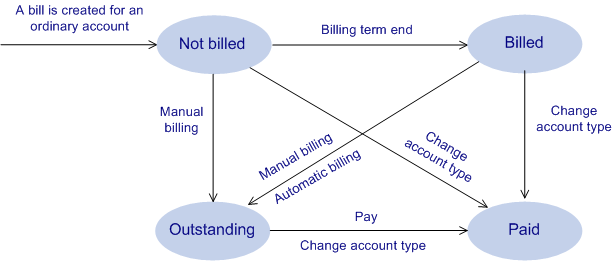A bill may be in one of these four states: Outstanding, Billed, Not billed, and Paid. Different services may be assigned different billing terms, while the system has a global billing term. For services with no billing terms, the global billing term applies.
(1) For an ordinary account, the status of the bill will change from Not billed to Billed when the current billing term ends. After billing, the bill will be in Outstanding state. The charges in a bill in outstanding state is added to the payment due for the billing term. After payment, the bill will be in Paid state, as shown in the following table:

(2) For a prepaid account, the bill status can only be Not billed and Paid. When the billing term ends, the status of the bill changes directly from Not billed to Paid, as shown in the following figure:

The period between the consecutive billing statement dates.
The CAMS Accounting Manager allows a user to use multiple services at the same time. Whenever a user starts to use a service, some of the user's currency resources are allocated to the service. When the resources are used up, some more will be allocated. Max. Currency Resource refers to the maximum volume of resources allocated to a service after the user passes authentication. To ensure that users can use the network normally, the volume of currency resources allocated every time must be at least enough for supporting a duration equal to an accounting update interval. For example, if the accounting update interval configured on the access device is 6 minutes, and the rate of the charging plan is 0.05 dollars per minute, the Max. Currency Resource must be greater than 0.3 dollars (6 * 0.05). Otherwise, users cannot use the network normally. This parameter does not apply when the charging model is Flat rate.
If a user uses a service but the usage does not reach the charging threshold, no charge will be made for the service usage. This parameter does not apply when the charging model is Flat rate.
The minimum service usage charged. If the service usage of a user is greater than the usage defined by Charging Threshold but less than Min. Charged Usage, the user will be charged as per Min. Charged Usage. For example, when Charging Threshold is 5 seconds and Min. Charged Usage is 180 seconds (3 minutes), if the duration of a call is longer than 5 seconds but shorter than 3 minutes, the user will be charged for a 3-minute usage. This parameter does not apply when the charging model is Flat rate.
This parameter is effective only when there is a discount for certain periods of time. Available discount types include Consistent with Start and Exact Charging. For description convenience, the term Actual Rate is used to refer to the rate calculated based on the basic rate and discount for the period. With Consistent with Start, a user will be charged according to the actual rate of the moment the user starts to use the service. With Exact Charging, however, the actual rate may vary over time. For example, when the basic rate of a service is 0.10 dollars per minute and a discount of 20% applies after 21:00 everyday, if a user uses the service from 20:55:00 to 21:05:00, the user will be charged one dollar (0.1 * 10) in the case of Consistent with Start and 0.90 dollars (0.1 * 5 + 0.1 * 80% * 5) in the case of Exact Charging. This parameter does not apply when the charging model is Flat rate.
For an access to a service, if the usage exceeds the Min. Charged Usage, the charge for the extra part will be calculated in units of the rounding interval. If the extra part is not a multiple of the rounding interval, the extra part will be rounded as per the rounding type. For example, when Min. Charged Usage is 180 seconds and Rounding Interval is 10 seconds, a usage of 4 minutes 5 seconds (245 seconds) will be rounded to 240 seconds in the case of Round Down, 250 seconds in the case of Round Up and Round Off. This parameter does not apply when the charging model is Flat rate.